| Article verified by a practicing veterinarian |
Stress, illness, helminthic infestations, unshed hair, and foreign bodies entering the esophagus are the main causes of intestinal dysfunction in cats.
Only a qualified veterinarian can make a diagnosis after examining the animal and conducting instrumental and laboratory tests.
The easiest way to relieve constipation caused by minor blockage of the intestines by hair or other non-life-threatening reasons is to give the animal a laxative . One of these drugs is Duphalac.
In this article we will look at how to give Duphalac to a cat..
Duphalac: description of the drug and its properties
The drug is suitable for relieving constipation in humans and animals. Available in the form of a light thick suspension. Produced in Holland . The packaging can be made in the form of a bottle with a screw cap or in the form of disposable bags. The release form in the form of chewable lozenges is not suitable for cats.
Duphalac is 2/3 lactulose. Lactulose is a substance that provokes the release of feces from the intestines.
This effect is achieved due to the following properties of lactulose:
- increases the absorption of fluid by the intestines;
- stimulates intestinal motility;
- increases the rate of absorption of calcium salts and phosphates;
- has a liquefying effect.
In addition to freeing the intestines from feces, Duphalac creates favorable conditions for the proliferation of beneficial lacto- and bifidobacteria , and also prevents the proliferation of pathogenic microflora. In the future, this leads to the normalization of stool and the resumption of normal intestinal function.
Laxative stool stimulants
The drugs in this group are strikingly different in their properties and chemical structure from other groups of medications. The active substance included in the medicine stimulates the muscles of the intestinal wall.
The result of the reaction is increased peristalsis of the large intestine. In case of an overdose of the drug, strong, very painful spasms of the smooth muscles of the digestive tract may occur.
Contraindications for the use of this group:
- Constipation in kittens whose intestinal muscle layer is underdeveloped and has a tendency to intussusception.
- Pregnant cats (the drug may cause miscarriage).
- Congenital organic malformations of the digestive tract (for example, short bowel syndrome).
With prolonged use, secondary lazy bowel syndrome often develops, in which stool without a laxative becomes impossible. For this reason, only a veterinarian can prescribe the drug and calculate the individual dosage.
When is Duphalac prescribed: indications for taking the drug
Since cats cannot complain to the owner about the presence of a delicate problem, the owner has to “guess” on his own.
Symptoms of constipation may include:
- Empty tray . Normally, adult cats have bowel movements 1-2 times a day. Kittens go to the toilet up to 5 times a day;
- The feces have the appearance of “sheep feces” - dry, small “pea” in size;
- The cat strains a lot and experiences discomfort during defecation ; this can often be accompanied by meowing and the appearance of scarlet blood in the stool;
- Changing your pet's behavior. He begins to hide in dark places and worry;
- Loss of appetite;
- On palpation, the tummy is hard and painful .
If you have one or more symptoms, you should not self-medicate.
After all, constipation can be caused by the entry of a foreign body into the gastrointestinal tract, which, with increased intestinal contractions as a result of taking the drug, can cause irreparable harm to the health of the animal. Therefore, before taking the drug, it is recommended to show the animal to a specialist. Also, don’t delay your visit to the doctor and wait for it to “go away on its own.” Worsening of the disease leads to intestinal blockage and poisoning of the body with accumulated toxins from the feces.
Timely treatment of an animal with Duphalac allows you to cure systematic constipation and restore normal intestinal functioning.
Next we’ll talk about how to give Duphalac to a cat for constipation and what to do if the cat refuses to take the medicine.
Veterinarian review
Intestinal microflora is of great importance for the health of the animal. It can be disrupted due to stress, poor nutrition, and chronic diseases. As a result, constipation occurs. To help the animal defecate, it is not necessary to give an enema. I prescribe the gentle laxative Duphalac. However, it cannot be used often. This is fraught with digestive upset.
All information posted on the site is provided in accordance with the User Agreement and is not a direct instruction to action. We strongly recommend that before using any product, you must obtain a face-to-face consultation at an accredited veterinary clinic.
Duphalac: dosage and how to give to a cat
Dosage
On how to give Duphalac to a cat for constipation and regarding the dosage of the drug, the instructions say that 0.5 - 1 ml of suspension is required per 1 kg of animal weight .
If the desired result does not occur within several hours, then it is worth finding out how often you can give your cat Duphalac. Experts say that re-taking the drug is possible after 8 hours . If after several doses (3 - 4) the animal’s intestines have not emptied, then the animal must be urgently taken to the veterinarian .
Treatment of constipation with folk remedies
If it is impossible to use industrial preparations, in the absence of severe organic pathology, you can use a laxative for cats at home:
- Pumpkin juice or boiled pumpkin are powerful stool stimulants for constipation. The development of the therapeutic effect is facilitated by the high content of plant fiber.
- Milk is the second most popular product that stimulates bowel movements. However, one should be aware of the common occurrence of lactose intolerance in felines.
- Flaxseed oil in its pure form perfectly loosens animal stool. As an alternative, olive and coconut oils are often used.
- Crushed sunflower seed husks not only stimulate intestinal motility, but are also a powerful sorbent. Can be used if food poisoning is suspected.
- For a number of congenital and metabolic diseases, laxative cat food (with a large amount of plant fiber) is used.
Oat bran or oatmeal decoction are widely used in home practice.
Such drugs form a coating of mucus and mucins on the intestinal walls, facilitating the passage of stool through the digestive tract.
How to give Duphalac to a cat
Having a peculiar taste, is unlikely to like . You should not hope that the cat will consume it with food, given that constipation reduces the animal’s appetite.
The most reliable way is to feed the prescribed dose through a syringe without a needle . Using a syringe is very convenient for dialing the required dosage, as well as for monitoring the use of the drug by an animal.
You can find detailed instructions on how to give medicine using a syringe in our recent material.
Storage requirements
The effectiveness of the drug Duphalac remains subject to proper storage conditions and until the expiration date of the drug. After three years have passed from the production date indicated on the bottle and packaging, the medicine should be thrown away. The product should be stored in a place where children and pets cannot access it. This could be a lockable first aid kit or a securely closed desk drawer designed for storing medications. Storage temperature is not higher than 25°C. Before giving medicine to an animal, you should perform a visual inspection and evaluate the smell. If the product has changed color to brown or dark gray, and also acquired a sour smell, the medication is hopelessly spoiled and must be disposed of.
Duphalac: contraindications and side effects
Uncontrolled use of drugs of this type leads to the body becoming accustomed to them, which entails disruption of the natural functioning of the intestines. how to properly give Duphalac to your cat and what to do if it doesn’t help.
As a general rule, if constipation in a pet cannot be eliminated within 2 days , then it is necessary to stop taking Duphalac and bring the animal for examination to a veterinarian . Further waiting and self-medication can lead to very sad consequences for the cat.
Contraindications
- Intestinal blockage caused by a foreign object or large hairball.
- Lack of lactase in the body . Lactase is an enzyme involved in the breakdown of lactose found in dairy products.
- Disturbance of metabolic processes in the animal's body, as well as galactosemia. Symptoms may include bloating, flatulence, severe pain, regurgitation of undigested food (non-specific symptom, it is better not to write).
Side effects
One of the side effects after taking the drug is dehydration . This is due to the fact that softening feces requires a large amount of water, which is drawn out of the animal’s body.
To prevent dehydration, the cat must be given food voluntarily or forcibly through a syringe without a needle if it refuses to drink on its own. Also, a veterinarian may suggest a course of IV drips, based on the condition of the animal at the time of examination.
In case of overdose, vomiting and diarrhea . Usually the symptoms go away quickly on their own and do not need correction.
Overdose
Sometimes the pet owner may make a mistake in the amount of laxative or violate the time period. In this case, the cat shows signs of an overdose of Duphalac :
- loose stools, sometimes with the appearance of foam;
- lack of appetite;
- vomit;
- bloating;
- flatulence.
These symptoms are accompanied by increased anxiety in the pet. To eliminate the consequences of exceeding the dose of Duphalac, take smecta. If the animal's condition worsens sharply, contact a veterinarian.











